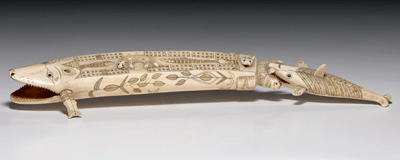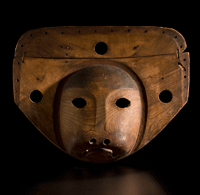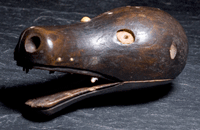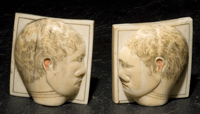|
Cowan's Corner
Eskimo Art
By Wes Cowan
Posted 8/2010
The Arctic is a cold and hostile land and amazingly has been inhabited for thousands of years. The environment, coupled with the Eskimo world view, has created a unique form of art which spans from mysterious and powerful to fun and whimsical.
Traditionally, the word Eskimo has been used to encompass all native people living in the Arctic, including both Yupik and Inuit traditions. However, the word Eskimo translated means “eaters of raw meat.” Not fond of the term, Canadian Eskimos petitioned for a name change, and in 1982, the Canadian government recognized this group as Inuit, meaning “the people.” Native Alaskans are still referred to as Eskimos, which again include both traditions.
Before there was a tourist market, Eskimo creativity could be seen on nearly all utilitarian items, such as bow drill handles, ulus (a type of knife), harpoon points, weaving shuttles and needle cases, among countless others. These items were often made of bone or walrus ivory and incised with circular geometrics, hunting vignettes or scenes of native wildlife. Other forms of art appeared in ceremonial pieces, such as masks and dance wands. These objects have eerie, supernatural qualities which are meant to invoke the inua, or spirits, of ancestors or animals killed in the hunt.
American whaling ships traveled to the Arctic starting in the mid-19th century, causing a shift in the native economies. Sailor-like scrimshaw combined with traditional forms created an era of curios which today are highly collectable. Visitors clamored to buy the small, fanciful crafts which dominated the streets of Nome. Walrus tusk cribbage boards, ivory butter knife sets, toothpicks and hors d’oeuvre forks, baskets in the form of oil lamps, and other Victorian-style commodities flooded the market.
Ethnologists and missionaries venturing into this unforgiving environment returned with other forms of art, focusing more on the traditional culture. Wooden masks, hunting gear, snuff boxes, pipes and other utilitarian objects were taken and brought back to museums around the country, including the Smithsonian’s National Museum of Natural History and the Field Museum in Chicago.
|

|
|
A Nunivak Island-carved ivory cribbage board sold for $7,050
in Cowan’s April 2009 American Indian Art Auction.
|
Early Eskimo art has seen a jump in collectability over the years. Although some pieces are still reasonably priced, other items will cost a collector will pay thousands of dollars. Curio pieces, such as Nunivak-carved walrus tusks, are among some of the most popular. These carvings are typically decorated with fat seals and fish swimming around each other without a care in the world—in the wings, some large, toothy animal is waiting for a snack. At auction, a Nunivak tusk can bring between $7,000 and $10,000. Baleen baskets, another well-liked form, are often finished with an ivory-carved finial and can range in price from $200-$1,500, depending on age, size and detail.
In a land of the Polar Night, Eskimo art is a beacon of light and creativity found in no other place. To collectors, it is a reminder of the harsh conditions that a people have struggled with and survived in for centuries.
 About the author: Wes Cowan is founder and owner of Cowan’s Auctions, Inc. in Cincinnati, Ohio. An internationally-recognized expert in historic Americana, Wes stars in the PBS television series History Detectives and is a featured appraiser on Antiques Roadshow. He can be reached via email at info@cowans.com. Research by Danica Farnand. About the author: Wes Cowan is founder and owner of Cowan’s Auctions, Inc. in Cincinnati, Ohio. An internationally-recognized expert in historic Americana, Wes stars in the PBS television series History Detectives and is a featured appraiser on Antiques Roadshow. He can be reached via email at info@cowans.com. Research by Danica Farnand.
|

This Eskimo seal mask sold for $88,125 in Cowan’s September 11, 2009 American Indian and Western Art Auction.

This Inupiaq Eskimo zoomorphic snuff box sold for $34,500 in Cowan’s March 2007 American Indian and Western Art Auction.

A pair of Eskimo-carved walrus ivory buttons sold for $3,450 in Cowan’s March 2007 American Indian and Western Art Auction.
|